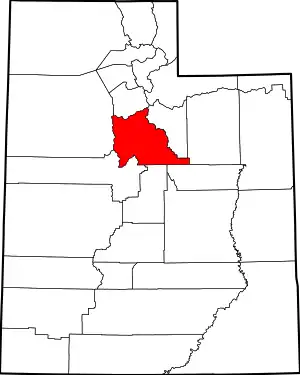Woodland Hills, Utah
Woodland Hills is a city in Utah County, Utah, United States. It is part of the Provo–Orem Metropolitan Statistical Area. The population was 1,344 at the 2010 census.[5] Woodland Hills became a city at the end of 2000.[6]
Woodland Hills, Utah | |
|---|---|
 Location in Utah County and the state of Utah | |
| Coordinates: 40°0′49″N 111°39′14″W | |
| Country | United States |
| State | Utah |
| County | Utah |
| Founded | 1970 |
| Incorporated (town) | December 14, 1979 |
| Incorporated (city) | November 3, 2000 |
| Area | |
| • Total | 2.53 sq mi (6.56 km2) |
| • Land | 2.53 sq mi (6.56 km2) |
| • Water | 0.00 sq mi (0.00 km2) |
| Elevation | 5,331 ft (1,625 m) |
| Population (2010) | |
| • Total | 1,344 |
| • Estimate (2019)[2] | 1,590 |
| • Density | 627.71/sq mi (242.34/km2) |
| Time zone | UTC-7 (Mountain (MST)) |
| • Summer (DST) | UTC-6 (MDT) |
| ZIP code | 84653 |
| Area code(s) | 385 801 |
| FIPS code | 49-85050[3] |
| GNIS feature ID | 1455585[4] |
| Website | woodlandhills-ut |
As of the 2000 census, Woodland Hills had the highest median income in the state of Utah.[7]
Geography
According to the United States Census Bureau, the city has a total area of 2.0 square miles (5.2 km2), all land.[8]
Demographics
| Historical population | |||
|---|---|---|---|
| Census | Pop. | %± | |
| 1980 | 60 | — | |
| 1990 | 301 | 401.7% | |
| 2000 | 941 | 212.6% | |
| 2010 | 1,344 | 42.8% | |
| 2019 (est.) | 1,590 | [2] | 18.3% |
| U.S. Decennial Census[9] | |||
As of the census[3] of 2000, there were 941 people, 500 households, and 207 families residing in the town. The population density was 343.3 people per square mile (132.6/km2). There were 229 housing units at an average density of 83.5 per square mile (32.3/km2). The racial makeup of the town was 97.24% White, 0.21% African American, 0.21% Native American, 0.11% Asian, 1.28% from other races, and 0.96% from two or more races. Hispanic or Latino of any race were 2.44% of the population.
There were 220 households, out of which 55.5% had children under the age of 18 living with them, 90.9% were married couples living together, 2.3% had a female householder with no husband present, and 5.9% were non-families. 3.6% of all households were made up of individuals, and 0.5% had someone living alone who was 65 years of age or older. The average household size was 4.28 and the average family size was 4.44.
In the town the population was spread out, with 43.6% under the age of 18, 8.1% from 18 to 24, 23.0% from 25 to 44, 18.4% from 45 to 64, and 7.0% who were 65 years of age or older. The median age was 22 years. For every 100 females, there were 101.1 males. For every 100 females age 18 and over, there were 97.4 males.
The median income for a household in the town was $80,854, and the median income for a family was $82,358. Males had a median income of $66,042 versus $32,361 for females. The per capita income for the town was $25,184. About 2.6% of families and 3.0% of the population were below the poverty line, including 2.2% of those under age 18 and 5.7% of those age 65 or over.
See also
- List of cities and towns in Utah
References
- "2019 U.S. Gazetteer Files". United States Census Bureau. Retrieved August 7, 2020.
- "Population and Housing Unit Estimates". United States Census Bureau. May 24, 2020. Retrieved May 27, 2020.
- "U.S. Census website". United States Census Bureau. Retrieved 2008-01-31.
- "US Board on Geographic Names". United States Geological Survey. 2007-10-25. Retrieved 2008-01-31.
- "Profile of General Population and Housing Characteristics: 2010 Demographic Profile Data (DP-1): Woodland Hills city, Utah". United States Census Bureau. Retrieved 8 Mar 2012.
- Trauntvein, Myrna (9 Dec 2000). "Mona is now a third-class city". Deseret News. Salt Lake City: Deseret Digital Media. p. A18. Retrieved 17 Jun 2009.
- "Utah 2000"
- "Geographic Identifiers: 2010 Demographic Profile Data (G001): Woodland Hills city, Utah". United States Census Bureau. Retrieved 8 Mar 2012.
- "Census of Population and Housing". Census.gov. Retrieved June 4, 2015.

